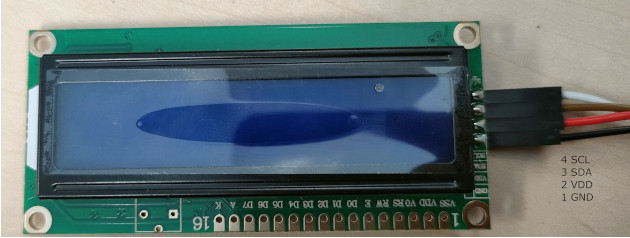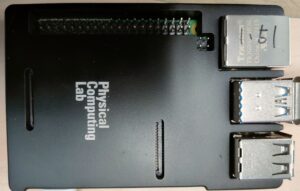RaspberryPi[37] I2C 1602モジュール FNK0079 Freenove LCD Module
Freenove製の液晶2列ラインモジュールです。I2Cで制御します。Freenoveのチュートリアルサイトで情報得ることができます。

| 信号線名 | ラズパイ ピン番号 | FNK0079ピン番号 |
| 3.3V | 1 | 2 |
| SDA | 3 | 3 |
| SCL | 5 | 4 |
| GND | 9 | 1 |
接続もチュートリアルにあります。接続が終わったら、i2cdetect コマンドでアドレスを確認します。
i2cdetect -y 1
27が表示されるのでアドレスは 0x27 となります。ちなみに、ラズパイのI2Cは複数設定できると書いてあるWEBがありますが、今のところ、i2c1 しか使えていません。
LCD Libraryはここにあります。普段使う関数を載せておきます。
#include <wiringPi.h> // 二つのヘッダをインクルードします。
#include <lcd.h>
lcdhd = lcdInit(2,16,4,RS,EN,D4,D5,D6,D7,0,0,0,0); // チュートリアルから持ってきました。戻り値がハンドルになります。
lcdHome (lcdhd);//LCDのカーソルを初期位置(1行目の1文字目)に戻します。
lcdClear (lcdhd); // 画面クリア
lcdPosition (lcdhd,x,y); // カーソルを移動します。
lcdPrintf (lcdhd, char *message, …) //文字を表示します。 printf()と同じ書式で行けます。以下はチュートリアルにあるサンプルコードです。
/**********************************************************************
* Filename : I2CLCD1602.c
* Description : Use the LCD display data
* Author : www.freenove.com
* modification: 2020/07/23
**********************************************************************/
#include <stdlib.h>
#include <stdio.h>
#include <wiringPi.h>
#include <wiringPiI2C.h>
#include <pcf8574.h>
#include <lcd.h>
#include <time.h>
int pcf8574_address = 0x27; // PCF8574T:0x27, PCF8574AT:0x3F
#define BASE 64 // BASE any number above 64
//Define the output pins of the PCF8574, which are directly connected to the LCD1602 pin.
#define RS BASE+0
#define RW BASE+1
#define EN BASE+2
#define LED BASE+3
#define D4 BASE+4
#define D5 BASE+5
#define D6 BASE+6
#define D7 BASE+7
int lcdhd;// used to handle LCD
void printCPUTemperature(){// sub function used to print CPU temperature
FILE *fp;
char str_temp[15];
float CPU_temp;
// CPU temperature data is stored in this directory.
fp=fopen("/sys/class/thermal/thermal_zone0/temp","r");
fgets(str_temp,15,fp); // read file temp
CPU_temp = atof(str_temp)/1000.0; // convert to Celsius degrees
printf("CPU's temperature : %.2f \n",CPU_temp);
lcdPosition(lcdhd,0,0); // set the LCD cursor position to (0,0)
lcdPrintf(lcdhd,"CPU:%.2fC",CPU_temp);// Display CPU temperature on LCD
fclose(fp);
}
void printDataTime(){//used to print system time
time_t rawtime;
struct tm *timeinfo;
time(&rawtime);// get system time
timeinfo = localtime(&rawtime);//convert to local time
printf("%s \n",asctime(timeinfo));
lcdPosition(lcdhd,0,1);// set the LCD cursor position to (0,1)
lcdPrintf(lcdhd,"Time:%02d:%02d:%02d",timeinfo->tm_hour,timeinfo->tm_min,timeinfo->tm_sec); //Display system time on LCD
}
int detectI2C(int addr){ //Used to detect i2c address of LCD
int _fd = wiringPiI2CSetup (addr);
if (_fd < 0){
printf("Error address : 0x%x \n",addr);
return 0 ;
}
else{
if(wiringPiI2CWrite(_fd,0) < 0){
printf("Not found device in address 0x%x \n",addr);
return 0;
}
else{
printf("Found device in address 0x%x \n",addr);
return 1 ;
}
}
}
int main(void){
int i;
printf("Program is starting ...\n");
wiringPiSetup();
if(detectI2C(0x27)){
pcf8574_address = 0x27;
}else if(detectI2C(0x3F)){
pcf8574_address = 0x3F;
}else{
printf("No correct I2C address found, \n"
"Please use command 'i2cdetect -y 1' to check the I2C address! \n"
"Program Exit. \n");
return -1;
}
pcf8574Setup(BASE,pcf8574_address);//initialize PCF8574
for(i=0;i<8;i++){
pinMode(BASE+i,OUTPUT); //set PCF8574 port to output mode
}
digitalWrite(LED,HIGH); //turn on LCD backlight
digitalWrite(RW,LOW); //allow writing to LCD
lcdhd = lcdInit(2,16,4,RS,EN,D4,D5,D6,D7,0,0,0,0);// initialize LCD and return “handle” used to handle LCD
if(lcdhd == -1){
printf("lcdInit failed !");
return 1;
}
while(1){
printCPUTemperature();//print CPU temperature
printDataTime(); // print system time
delay(1000);
}
return 0;
}
コンパイルには、wiringPi ライブラリが必要です。
gcc I2CLCD1602.c -o I2CLCD1602 -lwiringPi -lwiringPiDev
